Maximilian Stark
V2X Sidelink Positioning in FR1: From Ray-Tracing and Channel Estimation to Bayesian Tracking
Jun 25, 2024Abstract:Sidelink positioning research predominantly focuses on the snapshot positioning problem, often within the mmWave band. Only a limited number of studies have delved into vehicle-to-anything (V2X) tracking within sub-6 GHz bands. In this paper, we investigate the V2X sidelink tracking challenges over sub-6 GHz frequencies. We propose a Kalman-filter-based tracking approach that leverages the estimated error covariance lower bounds (EECLBs) as measurement covariance, alongside a gating method to augment tracking performance. Through simulations employing ray-tracing data and super-resolution channel parameter estimation, we validate the feasibility of sidelink tracking using our proposed tracking filter with two novel EECLBs. Additionally, we demonstrate the efficacy of the gating method in identifying line-of-sight paths and enhancing tracking performance.
Distributed Intelligent Integrated Sensing and Communications: The 6G-DISAC Approach
Feb 28, 2024Abstract:This paper introduces the concept of Distributed Intelligent integrated Sensing and Communications (DISAC), which expands the capabilities of Integrated Sensing and Communications (ISAC) towards distributed architectures. Additionally, the DISAC framework integrates novel waveform design with new semantic and goal-oriented communication paradigms, enabling ISAC technologies to transition from traditional data fusion to the semantic composition of diverse sensed and shared information. This progress facilitates large-scale, energy-efficient support for high-precision spatial-temporal processing, optimizing ISAC resource utilization, and enabling effective multi-modal sensing performance. Addressing key challenges such as efficient data management and connect-compute resource utilization, 6G- DISAC stands to revolutionize applications in diverse sectors including transportation, healthcare, and industrial automation. Our study encapsulates the project vision, methodologies, and potential impact, marking a significant stride towards a more connected and intelligent world.
Towards Distributed and Intelligent Integrated Sensing and Communications for 6G Networks
Feb 18, 2024



Abstract:This paper introduces the distributed and intelligent integrated sensing and communications (DISAC) concept, a transformative approach for 6G wireless networks that extends the emerging concept of integrated sensing and communications (ISAC). DISAC addresses the limitations of the existing ISAC models and, to overcome them, it introduces two novel foundational functionalities for both sensing and communications: a distributed architecture and a semantic and goal-oriented framework. The distributed architecture enables large-scale and energy-efficient tracking of connected users and objects, leveraging the fusion of heterogeneous sensors. The semantic and goal-oriented intelligent and parsimonious framework, enables the transition from classical data fusion to the composition of semantically selected information, offering new paradigms for the optimization of resource utilization and exceptional multi-modal sensing performance across various use cases. This paper details DISAC's principles, architecture, and potential applications.
V2X Sidelink Positioning in FR1: Scenarios, Algorithms, and Performance Evaluation
Oct 20, 2023Abstract:In this paper, we investigate sub-6 GHz V2X sidelink positioning scenarios in 5G vehicular networks through a comprehensive end-to-end methodology encompassing ray-tracing-based channel modeling, novel theoretical performance bounds, high-resolution channel parameter estimation, and geometric positioning using a round-trip-time (RTT) protocol. We first derive a novel, approximate Cram\'er-Rao bound (CRB) on the connected road user (CRU) position, explicitly taking into account multipath interference, path merging, and the RTT protocol. Capitalizing on tensor decomposition and ESPRIT methods, we propose high-resolution channel parameter estimation algorithms specifically tailored to dense multipath V2X sidelink environments, designed to detect multipath components (MPCs) and extract line-of-sight (LoS) parameters. Finally, using realistic ray-tracing data and antenna patterns, comprehensive simulations are conducted to evaluate channel estimation and positioning performance, indicating that sub-meter accuracy can be achieved in sub-6 GHz V2X with the proposed algorithms.
Analysis of V2X Sidelink Positioning in sub-6 GHz
Oct 27, 2022Abstract:Radio positioning is an important part of joint communication and sensing in beyond 5G communication systems. Existing works mainly focus on the mmWave bands and under-utilize the sub-6 GHz bands, even though it is promising for accurate positioning, especially when the multipath is uncomplicated, and meaningful in several important use cases. In this paper, we analyze V2X sidelink positioning and propose a new performance bound that can predict the positioning performance in the presence of severe multipath. Simulation results using ray-tracing data demonstrate the possibility of sidelink positioning, and the efficacy of the new performance bound and its relation with the complexity of the multipath.
Reconstruction-Computation-Quantization (RCQ): A Paradigm for Low Bit Width LDPC Decoding
Nov 17, 2021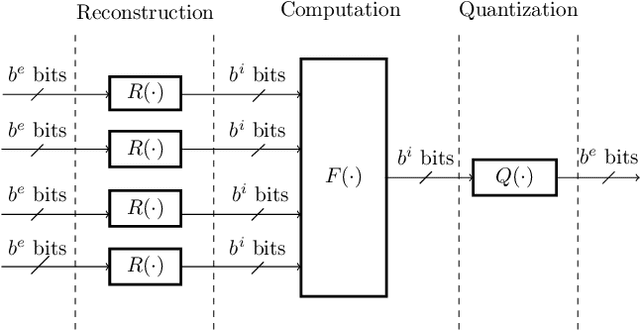
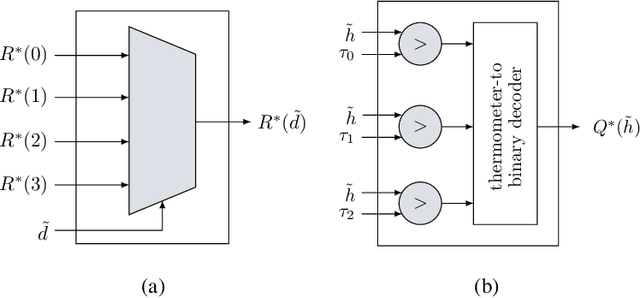
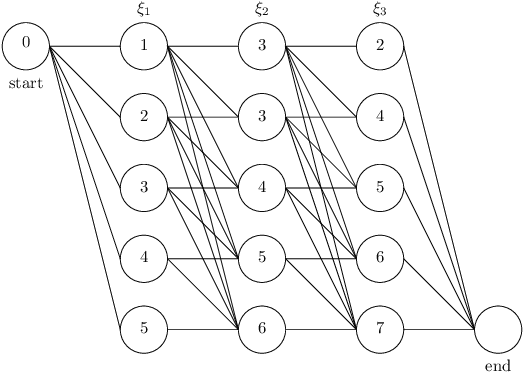
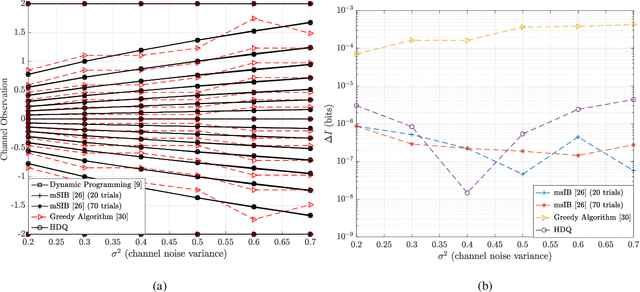
Abstract:This paper uses the reconstruction-computation-quantization (RCQ) paradigm to decode low-density parity-check (LDPC) codes. RCQ facilitates dynamic non-uniform quantization to achieve good frame error rate (FER) performance with very low message precision. For message-passing according to a flooding schedule, the RCQ parameters are designed by discrete density evolution (DDE). Simulation results on an IEEE 802.11 LDPC code show that for 4-bit messages, a flooding MinSum RCQ decoder outperforms table-lookup approaches such as information bottleneck (IB) or Min-IB decoding, with significantly fewer parameters to be stored. Additionally, this paper introduces layer-specific RCQ (LS-RCQ), an extension of RCQ decoding for layered architectures. LS-RCQ uses layer-specific message representations to achieve the best possible FER performance. For LS-RCQ, this paper proposes using layered DDE featuring hierarchical dynamic quantization (HDQ) to design LS-RCQ parameters efficiently. Finally, this paper studies field-programmable gate array (FPGA) implementations of RCQ decoders. Simulation results for a (9472, 8192) quasi-cyclic (QC) LDPC code show that a layered MinSum RCQ decoder with 3-bit messages achieves more than a $10\%$ reduction in LUTs and routed nets and more than a $6\%$ decrease in register usage while maintaining comparable decoding performance, compared to a 5-bit offset MinSum decoder.
Joint Learning of Geometric and Probabilistic Constellation Shaping
Jun 18, 2019



Abstract:The choice of constellations largely affects the performance of communication systems. When designing constellations, both the locations and probability of occurrence of the points can be optimized. These approaches are referred to as geometric and probabilistic shaping, respectively. Usually, the geometry of the constellation is fixed, e.g., quadrature amplitude modulation (QAM) is used. In such cases, the achievable information rate can still be improved by probabilistic shaping. In this work, we show how autoencoders can be leveraged to perform probabilistic shaping of constellations. We devise an information-theoretical description of autoencoders, which allows learning of capacity-achieving symbol distributions and constellations. Recently, machine learning techniques to perform geometric shaping were proposed. However, probabilistic shaping is more challenging as it requires the optimization of discrete distributions. Furthermore, the proposed method enables joint probabilistic and geometric shaping of constellations over any channel model. Simulation results show that the learned constellations achieve information rates very close to capacity on an additive white Gaussian noise (AWGN) channel and outperform existing approaches on both AWGN and fading channels.
Decoding of Non-Binary LDPC Codes Using the Information Bottleneck Method
Oct 21, 2018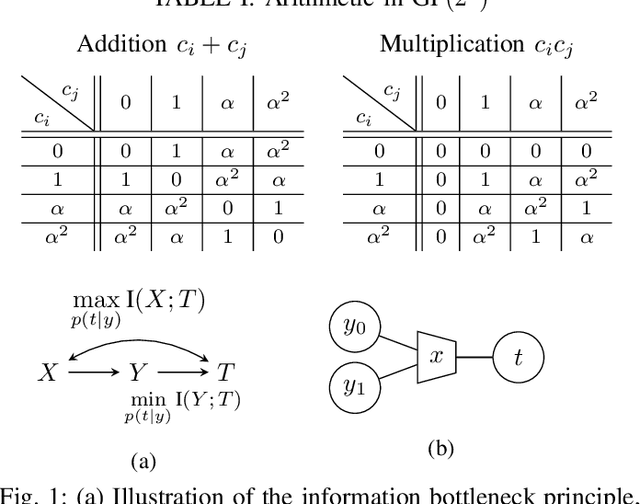
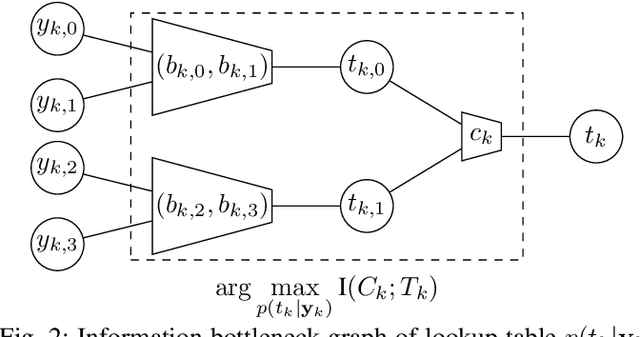
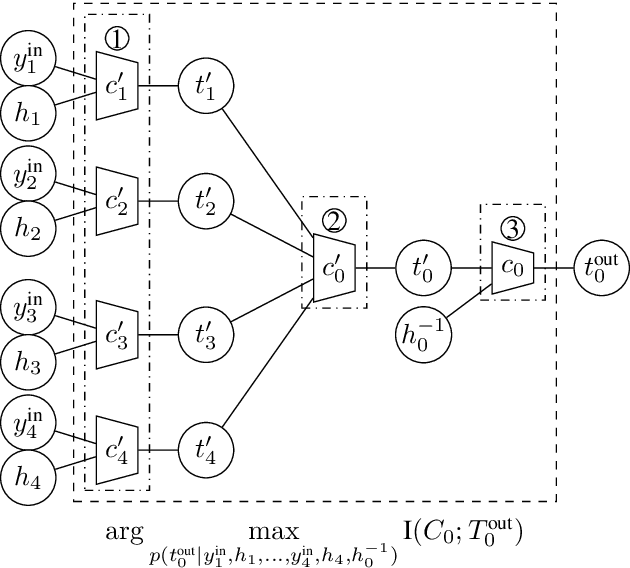
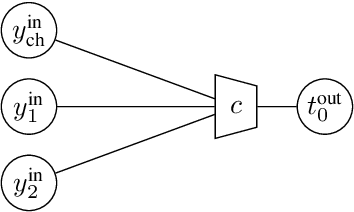
Abstract:Recently, a novel lookup table based decoding method for binary low-density parity-check codes has attracted considerable attention. In this approach, mutual-information maximizing lookup tables replace the conventional operations of the variable nodes and the check nodes in message passing decoding. Moreover, the exchanged messages are represented by integers with very small bit width. A machine learning framework termed the information bottleneck method is used to design the corresponding lookup tables. In this paper, we extend this decoding principle from binary to non-binary codes. This is not a straightforward extension, but requires a more sophisticated lookup table design to cope with the arithmetic in higher order Galois fields. Provided bit error rate simulations show that our proposed scheme outperforms the log-max decoding algorithm and operates close to sum-product decoding.
 Add to Chrome
Add to Chrome Add to Firefox
Add to Firefox Add to Edge
Add to Edge